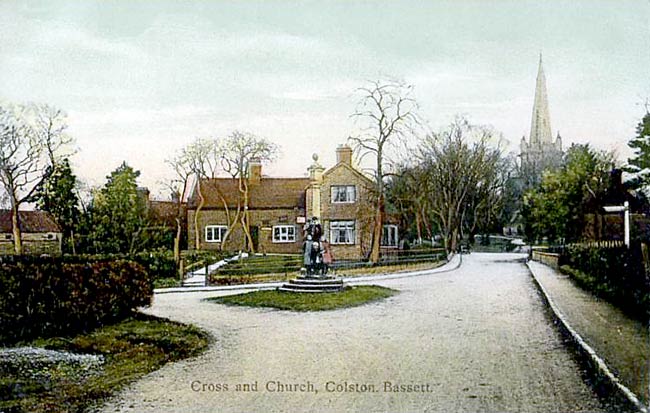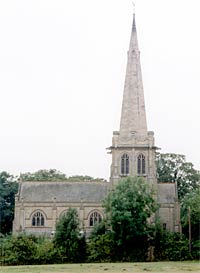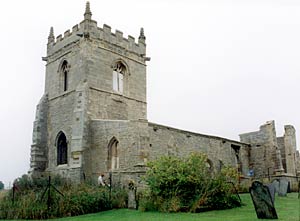< Previous | Contents | Next >
She Walks in Beauty

The old cross at the junction of Hall Lane, School Lane and Church Lane, Colston Bassett, c.1905.
COLSTON BASSETT. She walks in beauty; this charming patch of a secluded countryside has beauty at every step. In a lane like a grove of trees, where a stepped wall runs by the grounds of the hall in its park of 90 acres, a stone bridge spans the tiny River Smite. In a delightful setting where the ways meet is the charming old cross, rising with slender grace from a flight of steps. It is 15 feet high, and was rebuilt on the ancient base about a century ago. By another road embowered in trees (planted in 1710) is the stone church built in 1892 in memory of a beloved wife and her son, looking across the park to the fine old house where they lived.

Colston Bassett church in 2003.
Rich with elaborate battlements and pinnacles, the church has a central tower resting on lofty arches and crowned by a spire rising to 150 feet. The transomed east window glows richly with eight scenes from the life of Our Lord. The great attraction of the church is the fine carving in stone, especially notable in the undercutting of the capitals of the nave arcades and in the stone base of the oak pulpit, where the luxuriant foliage seems to be symbolical of the wealth of trees in the village. On the slender pillars supporting the roof are four angels, and the stone reredos has coloured panels of Our Lord and the Four Evangelists. The Hall pew has an elaborately carved oak canopy.
A lovely winged figure in the chapel, sculptured in marble, is to Alice Catherine Knowles; it was in memory of her and her son that her husband built the church. The son was drowned in Cumberland when 21, and there is an inscription to him and to a brother who fell in the Boer War.

The old church undergoing restoration in 2003.
We read on the wall of Joshua Brooke, who followed his father as vicar and served for 53 years before he died in 1888. It was another church he knew, and it is sad that the coming of this new church meant the loss of the old, which is falling in ruin. High up on the edge of the park, in a glorious situation, are the pitiful remains of the 13th and 14th century church of St Mary, which once had the shape of a cross and was one of the most beautiful in the county. The walls are overgrown with creeper, but we can see the embattled parapet and two pinnacles, remains of fine windows, and fragments of a still earlier church in the capitals of two Norman pillars. Of its famous peal of bells, five now make melody in the new church, and the old font has found a resting-place in the new churchyard, where there is a fine cross to 14 men who did not come back.
From the personal history of this place we gather that Francis Hacker, who led Charles Stuart to the scaffold, inherited land here from his father; and that in a skirmish here in 1643, when Francis and his brother were fighting on opposite sides, Thomas was killed. Here before the Hackers were the Bassetts, who gave the village part of its name. The founder of the house was Ralph, Chief Justice in the reign of Henry the First, remembered for the severity of his rule. He was responsible for carrying out the king's orders for the punishment of robbery, and we read in the Saxon Chronicle that "Ralph Bassett and the king's thanes held a Witenagemot in Leicestershire, and hanged four-and-forty men, and deprived six of their eyes and certain other members."
